FIAT 500E 2014 2.G Owners Manual
Manufacturer: FIAT, Model Year: 2014, Model line: 500E, Model: FIAT 500E 2014 2.GPages: 363, PDF Size: 2.66 MB
Page 171 of 363
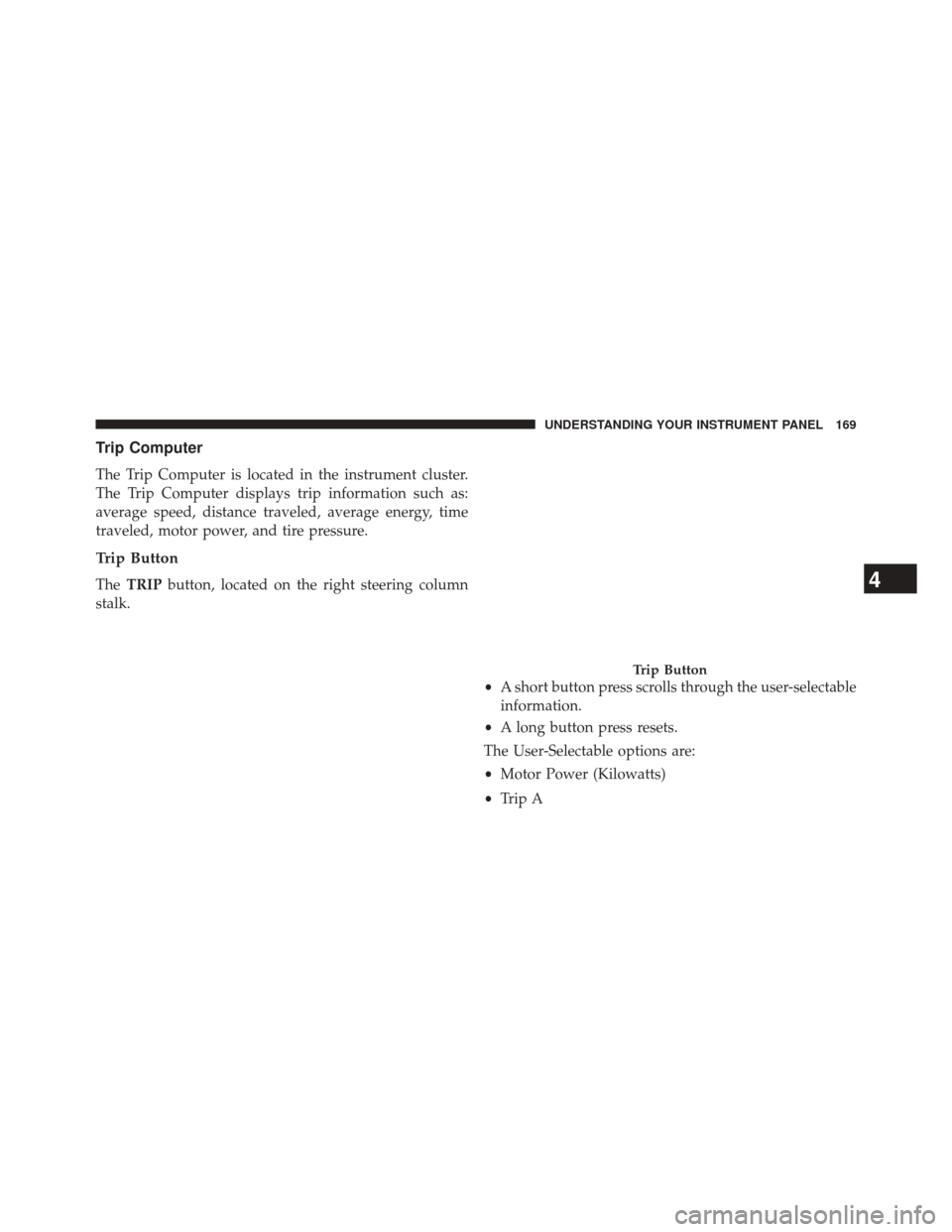
Trip Computer
The Trip Computer is located in the instrument cluster.
The Trip Computer displays trip information such as:
average speed, distance traveled, average energy, time
traveled, motor power, and tire pressure.
Trip Button
TheTRIP button, located on the right steering column
stalk.
•A short button press scrolls through the user-selectable
information.
• A long button press resets.
The User-Selectable options are:
• Motor Power (Kilowatts)
• Trip A
Trip Button
4
UNDERSTANDING YOUR INSTRUMENT PANEL 169
Page 172 of 363
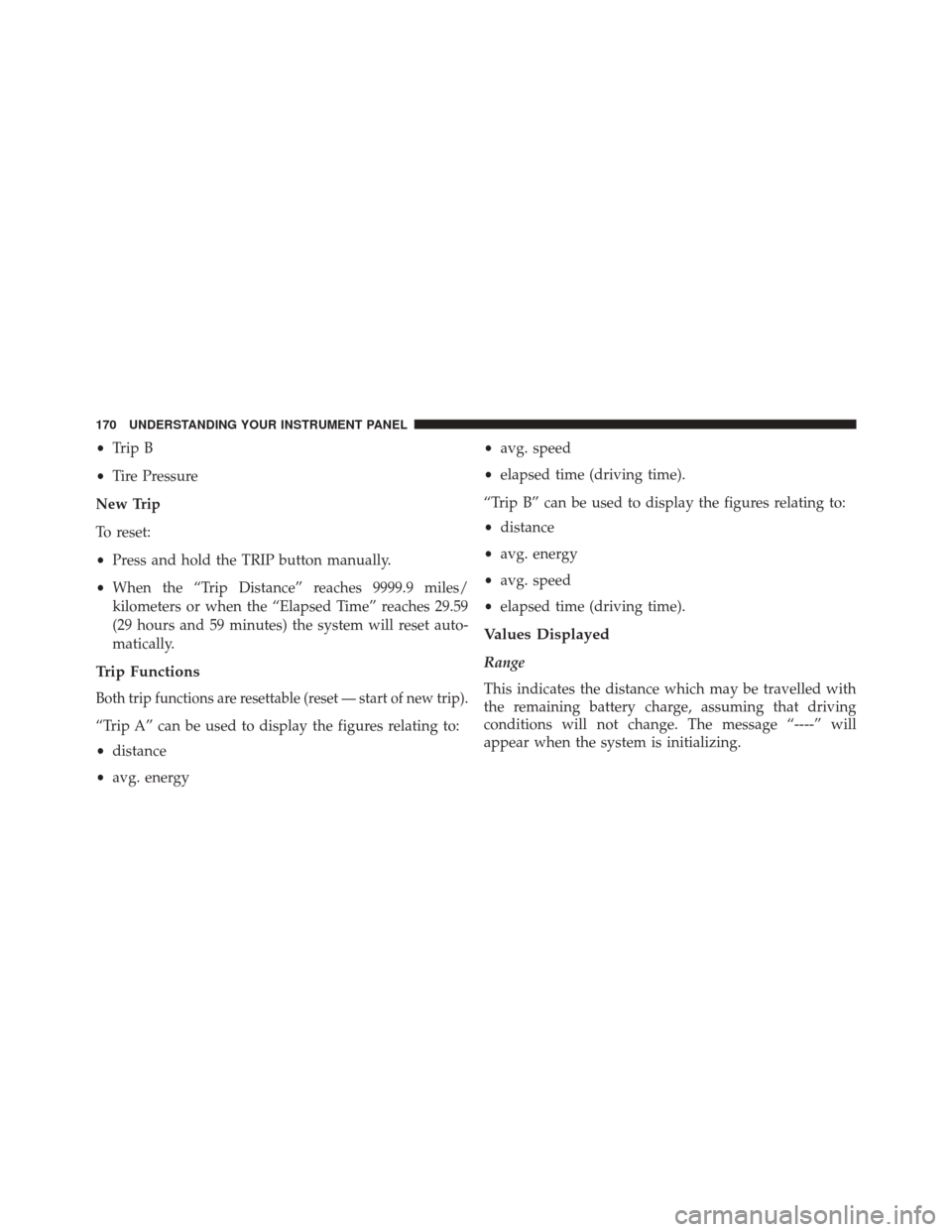
•Trip B
• Tire Pressure
New Trip
To reset:
• Press and hold the TRIP button manually.
• When the “Trip Distance” reaches 9999.9 miles/
kilometers or when the “Elapsed Time” reaches 29.59
(29 hours and 59 minutes) the system will reset auto-
matically.
Trip Functions
Both trip functions are resettable (reset — start of new trip).
“Trip A” can be used to display the figures relating to:
• distance
• avg. energy •
avg. speed
• elapsed time (driving time).
“Trip B” can be used to display the figures relating to:
• distance
• avg. energy
• avg. speed
• elapsed time (driving time).
Values Displayed
Range
This indicates the distance which may be travelled with
the remaining battery charge, assuming that driving
conditions will not change. The message “----” will
appear when the system is initializing.
170 UNDERSTANDING YOUR INSTRUMENT PANEL
Page 173 of 363
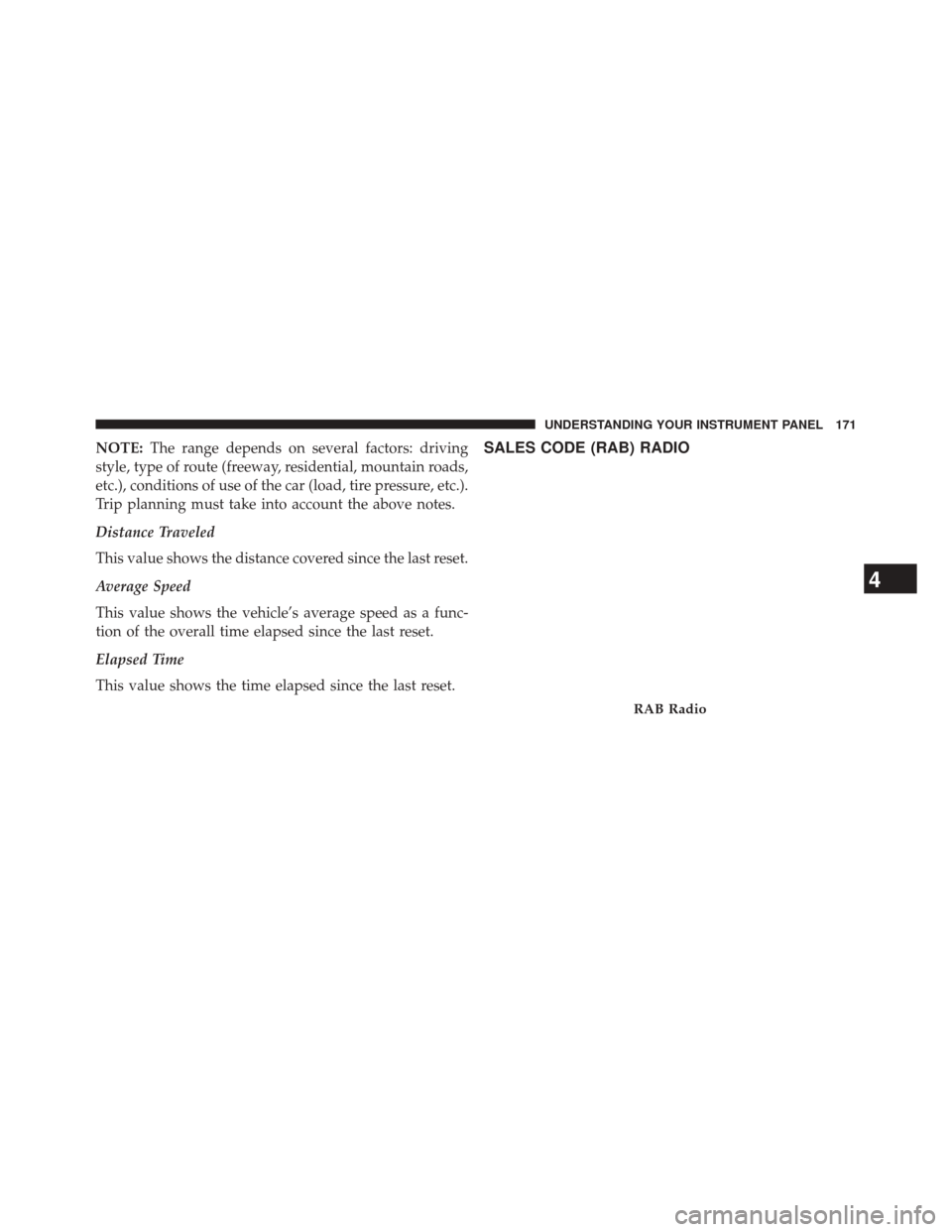
NOTE:The range depends on several factors: driving
style, type of route (freeway, residential, mountain roads,
etc.), conditions of use of the car (load, tire pressure, etc.).
Trip planning must take into account the above notes.
Distance Traveled
This value shows the distance covered since the last reset.
Average Speed
This value shows the vehicle’s average speed as a func-
tion of the overall time elapsed since the last reset.
Elapsed Time
This value shows the time elapsed since the last reset.SALES CODE (RAB) RADIO
RAB Radio
4
UNDERSTANDING YOUR INSTRUMENT PANEL 171
Page 174 of 363
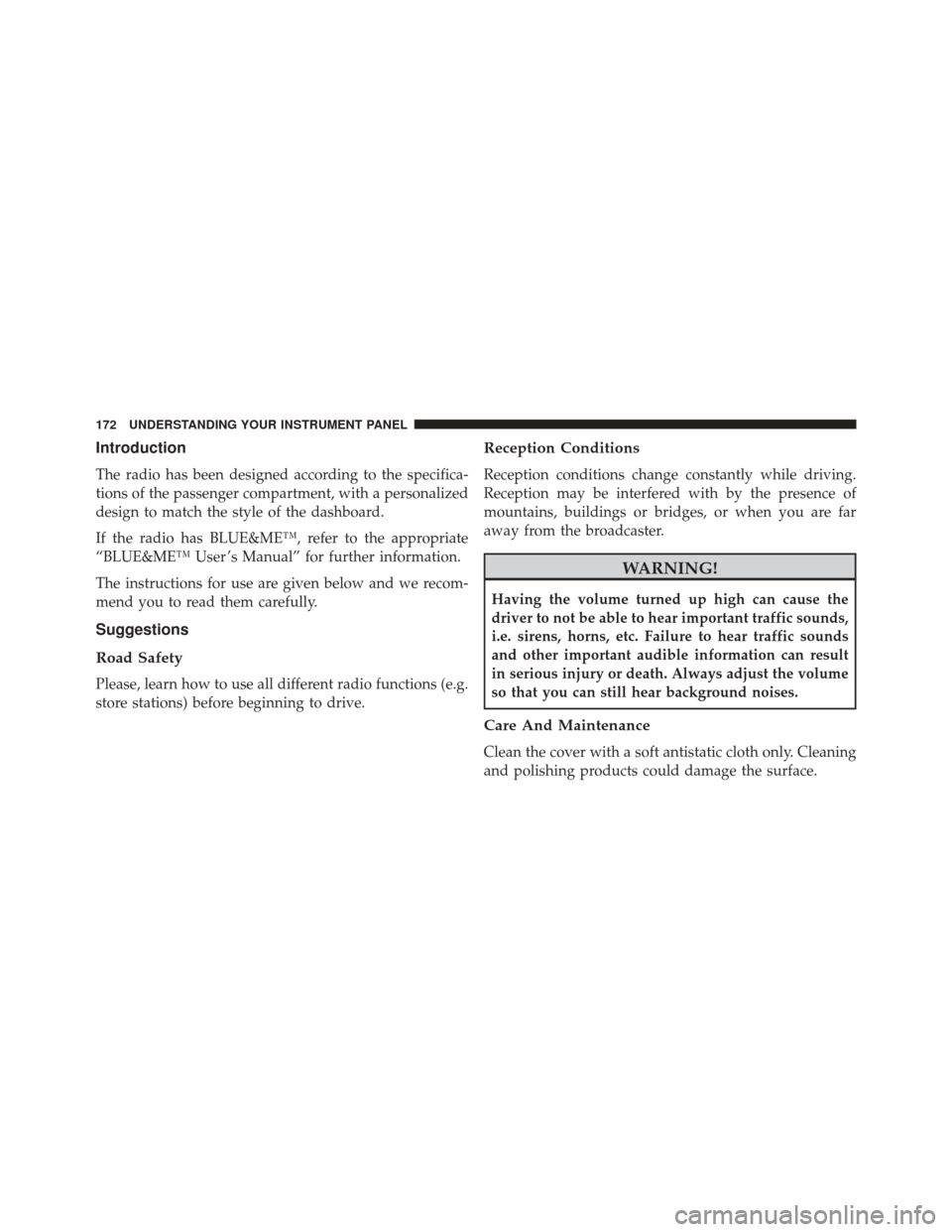
Introduction
The radio has been designed according to the specifica-
tions of the passenger compartment, with a personalized
design to match the style of the dashboard.
If the radio has BLUE&ME™, refer to the appropriate
“BLUE&ME™ User ’s Manual” for further information.
The instructions for use are given below and we recom-
mend you to read them carefully.
Suggestions
Road Safety
Please, learn how to use all different radio functions (e.g.
store stations) before beginning to drive.
Reception Conditions
Reception conditions change constantly while driving.
Reception may be interfered with by the presence of
mountains, buildings or bridges, or when you are far
away from the broadcaster.
WARNING!
Having the volume turned up high can cause the
driver to not be able to hear important traffic sounds,
i.e. sirens, horns, etc. Failure to hear traffic sounds
and other important audible information can result
in serious injury or death. Always adjust the volume
so that you can still hear background noises.
Care And Maintenance
Clean the cover with a soft antistatic cloth only. Cleaning
and polishing products could damage the surface.
172 UNDERSTANDING YOUR INSTRUMENT PANEL
Page 175 of 363
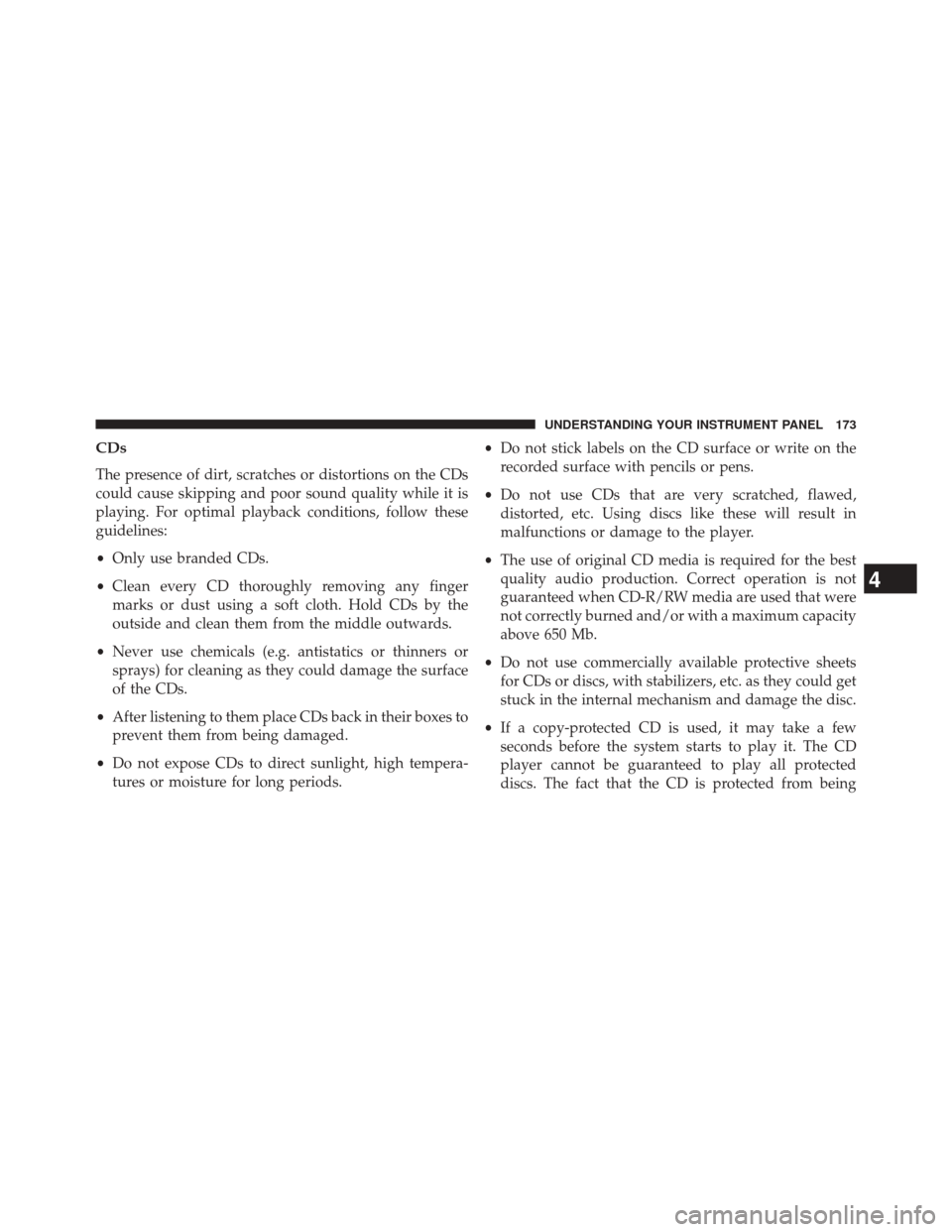
CDs
The presence of dirt, scratches or distortions on the CDs
could cause skipping and poor sound quality while it is
playing. For optimal playback conditions, follow these
guidelines:
•Only use branded CDs.
• Clean every CD thoroughly removing any finger
marks or dust using a soft cloth. Hold CDs by the
outside and clean them from the middle outwards.
• Never use chemicals (e.g. antistatics or thinners or
sprays) for cleaning as they could damage the surface
of the CDs.
• After listening to them place CDs back in their boxes to
prevent them from being damaged.
• Do not expose CDs to direct sunlight, high tempera-
tures or moisture for long periods. •
Do not stick labels on the CD surface or write on the
recorded surface with pencils or pens.
• Do not use CDs that are very scratched, flawed,
distorted, etc. Using discs like these will result in
malfunctions or damage to the player.
• The use of original CD media is required for the best
quality audio production. Correct operation is not
guaranteed when CD-R/RW media are used that were
not correctly burned and/or with a maximum capacity
above 650 Mb.
• Do not use commercially available protective sheets
for CDs or discs, with stabilizers, etc. as they could get
stuck in the internal mechanism and damage the disc.
• If a copy-protected CD is used, it may take a few
seconds before the system starts to play it. The CD
player cannot be guaranteed to play all protected
discs. The fact that the CD is protected from being
4
UNDERSTANDING YOUR INSTRUMENT PANEL 173
Page 176 of 363
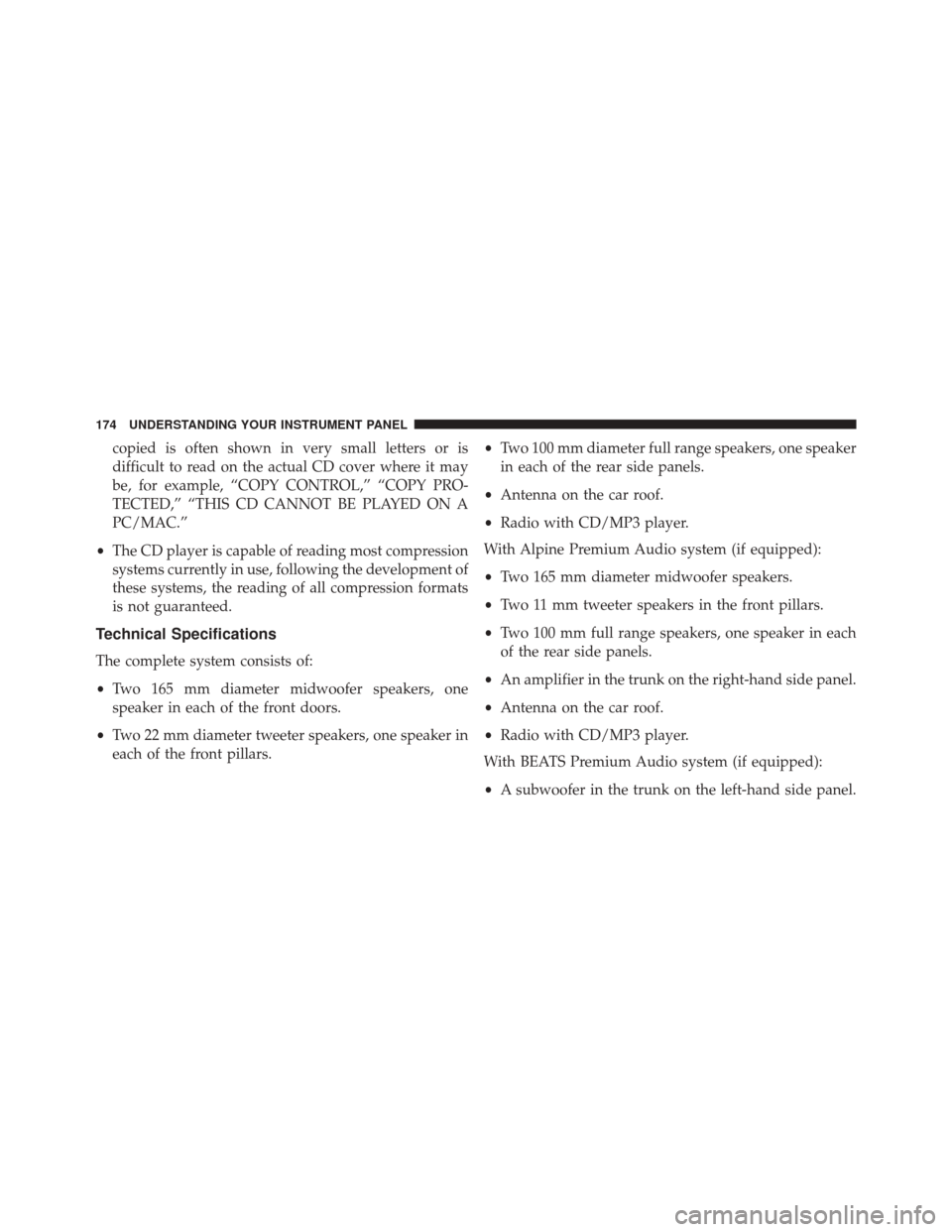
copied is often shown in very small letters or is
difficult to read on the actual CD cover where it may
be, for example, “COPY CONTROL,” “COPY PRO-
TECTED,” “THIS CD CANNOT BE PLAYED ON A
PC/MAC.”
• The CD player is capable of reading most compression
systems currently in use, following the development of
these systems, the reading of all compression formats
is not guaranteed.
Technical Specifications
The complete system consists of:
• Two 165 mm diameter midwoofer speakers, one
speaker in each of the front doors.
• Two 22 mm diameter tweeter speakers, one speaker in
each of the front pillars. •
Two 100 mm diameter full range speakers, one speaker
in each of the rear side panels.
• Antenna on the car roof.
• Radio with CD/MP3 player.
With Alpine Premium Audio system (if equipped):
• Two 165 mm diameter midwoofer speakers.
• Two 11 mm tweeter speakers in the front pillars.
• Two 100 mm full range speakers, one speaker in each
of the rear side panels.
• An amplifier in the trunk on the right-hand side panel.
• Antenna on the car roof.
• Radio with CD/MP3 player.
With BEATS Premium Audio system (if equipped):
• A subwoofer in the trunk on the left-hand side panel.
174 UNDERSTANDING YOUR INSTRUMENT PANEL
Page 177 of 363
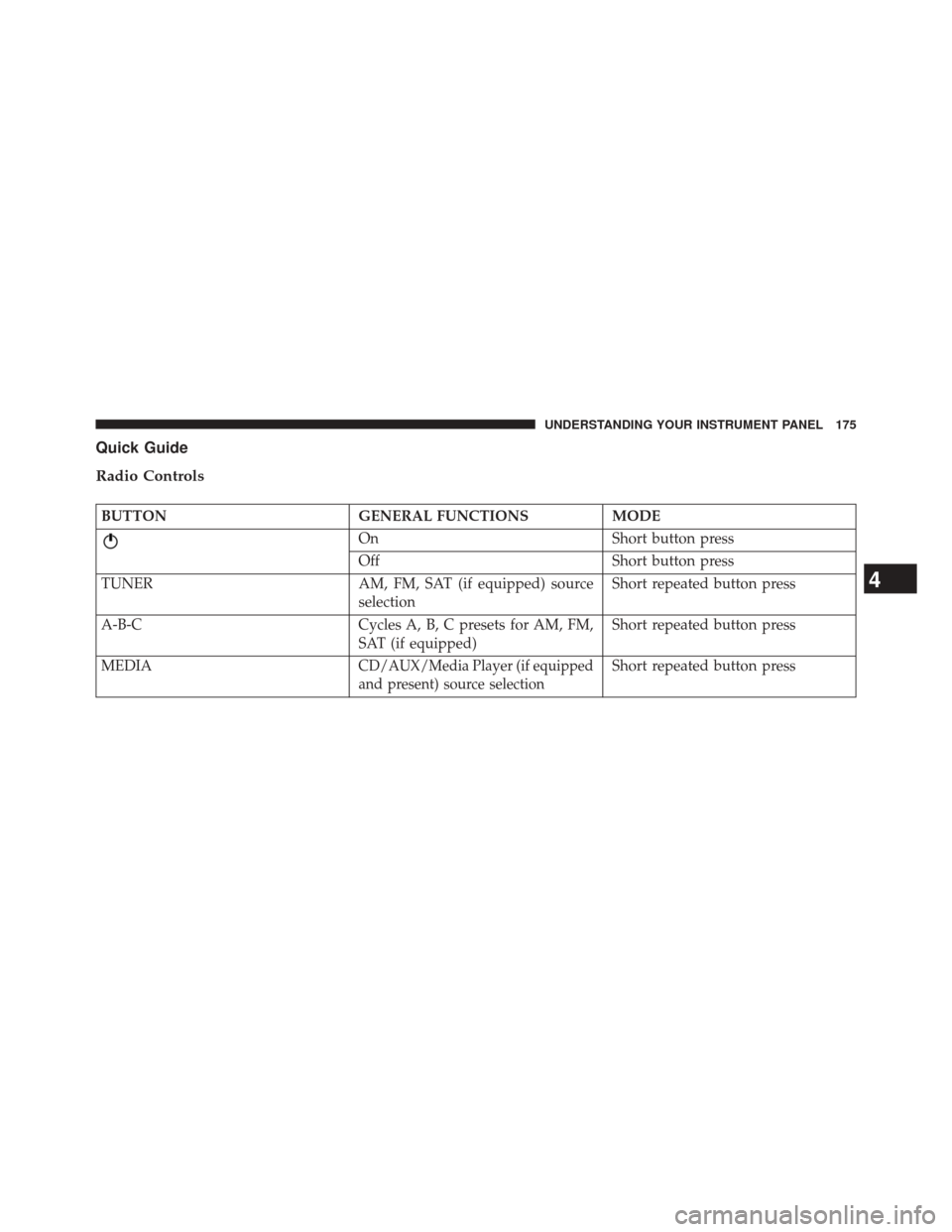
Quick Guide
Radio Controls
BUTTONGENERAL FUNCTIONSMODE
OnShort button press
Off Short button press
TUNER AM, FM, SAT (if equipped) source
selection Short repeated button press
A-B-C Cycles A, B, C presets for AM, FM,
SAT (if equipped)Short repeated button press
MEDIA
CD/AUX/Media Player (if equipped
and present) source selectionShort repeated button press
4
UNDERSTANDING YOUR INSTRUMENT PANEL 175
Page 178 of 363
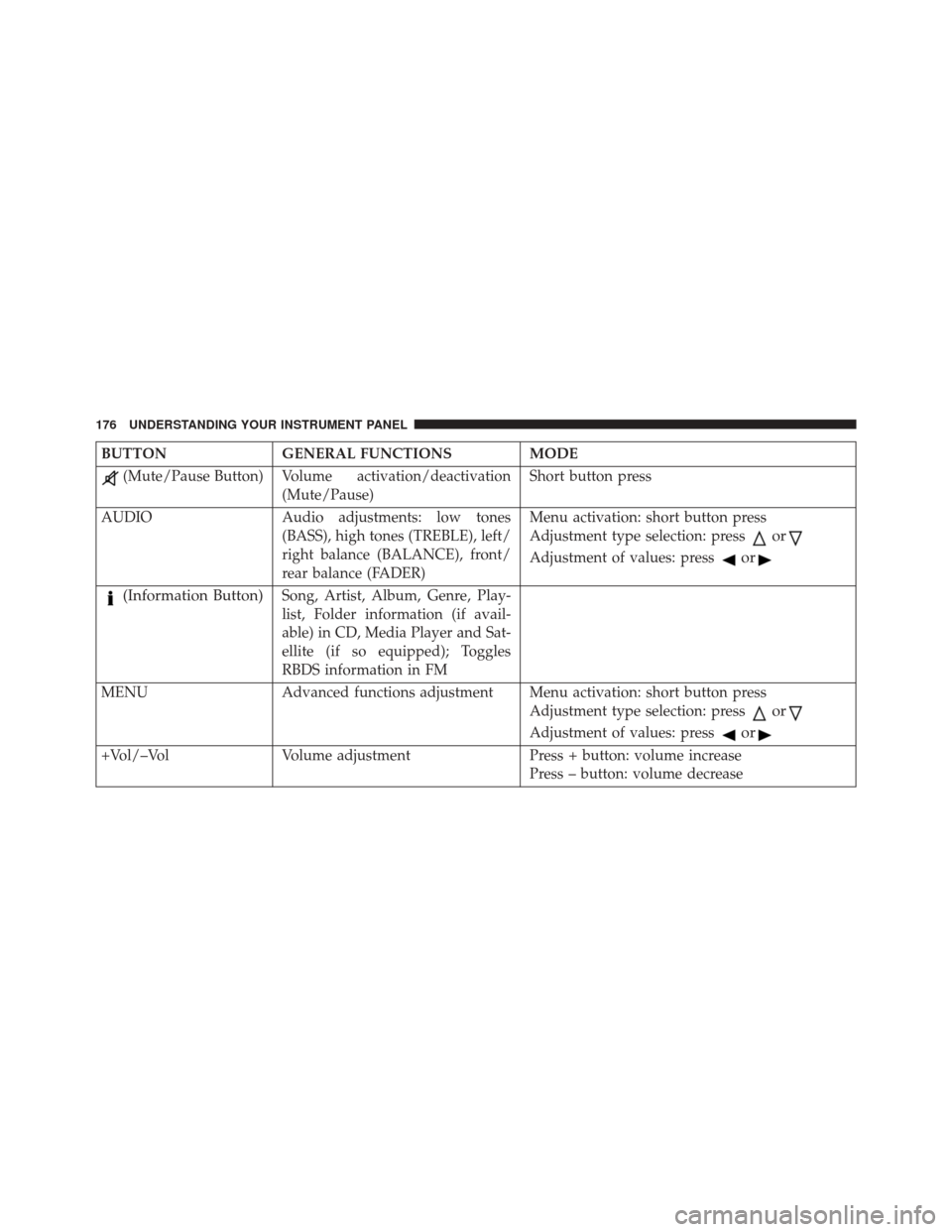
BUTTONGENERAL FUNCTIONS MODE
(Mute/Pause Button) Volume activation/deactivation
(Mute/Pause) Short button press
AUDIO Audio adjustments: low tones
(BASS), high tones (TREBLE), left/
right balance (BALANCE), front/
rear balance (FADER) Menu activation: short button press
Adjustment type selection: press
or
Adjustment of values: pressor
(Information Button)Song, Artist, Album, Genre, Play-
list, Folder information (if avail-
able) in CD, Media Player and Sat-
ellite (if so equipped); Toggles
RBDS information in FM
MENU Advanced functions adjustment Menu activation: short button press Adjustment type selection: press
or
Adjustment of values: pressor
+Vol/–VolVolume adjustment Press + button: volume increase
Press – button: volume decrease
176 UNDERSTANDING YOUR INSTRUMENT PANEL
Page 179 of 363
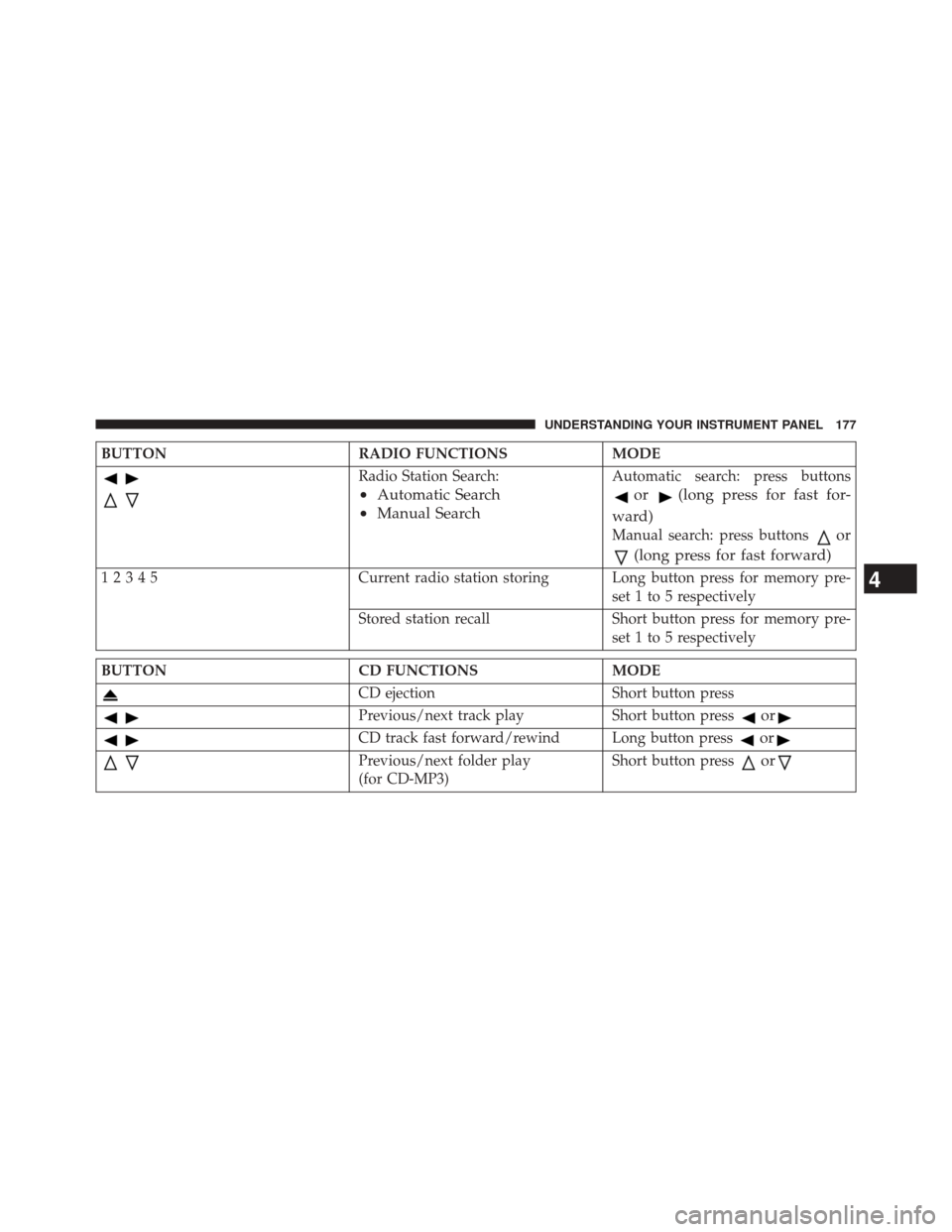
BUTTONRADIO FUNCTIONSMODE
Radio Station Search:
•Automatic Search
• Manual Search
Automatic search: press buttons
or(long press for fast for-
ward)
Manual search: press buttonsor
(long press for fast forward)
12345 Current radio station storing Long button press for memory pre-
set 1 to 5 respectively
Stored station recall Short button press for memory pre- set 1 to 5 respectively
BUTTON CD FUNCTIONSMODE
CD ejectionShort button press
Previous/next track playShort button pressor
CD track fast forward/rewind Long button pressor
Previous/next folder play
(for CD-MP3)Short button pressor
4
UNDERSTANDING YOUR INSTRUMENT PANEL 177
Page 180 of 363
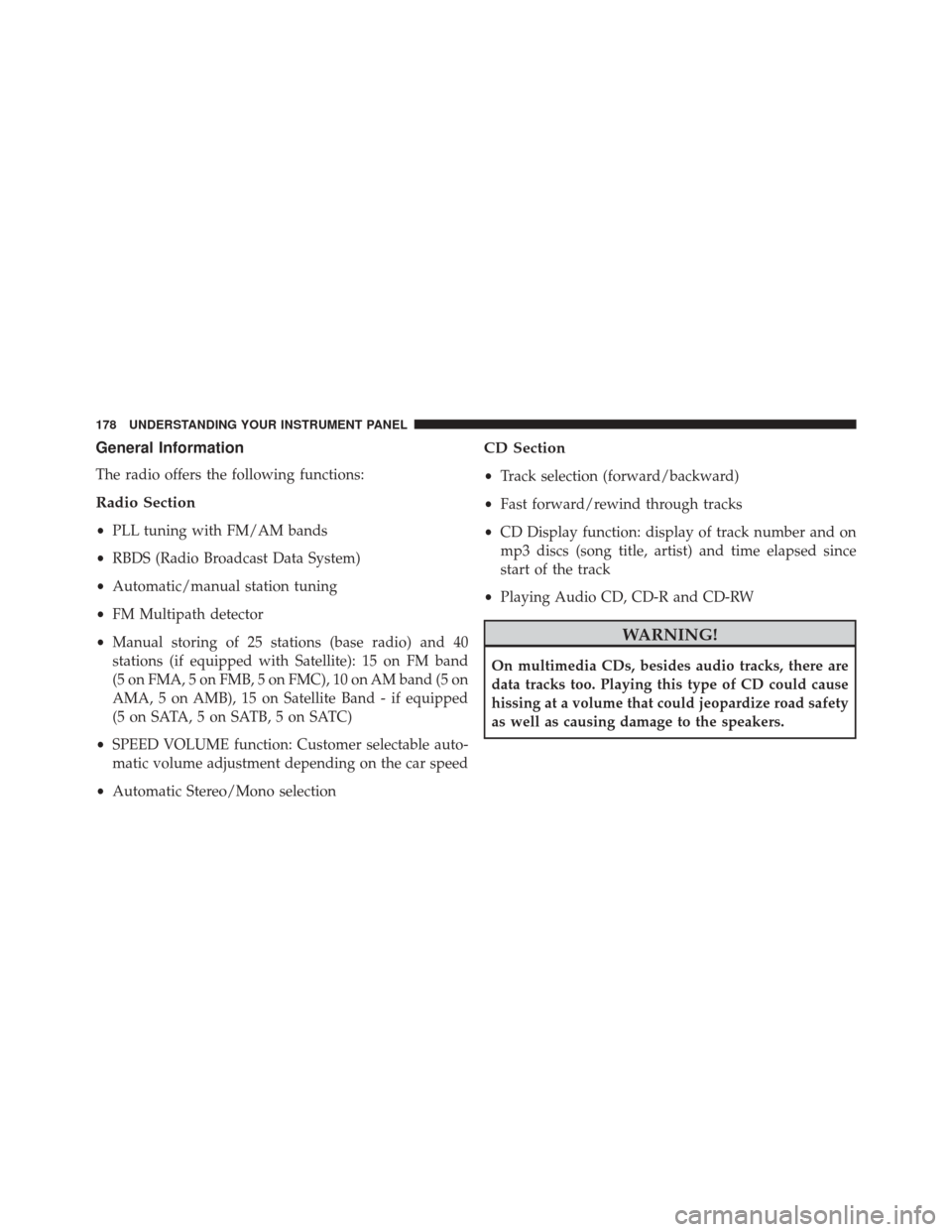
General Information
The radio offers the following functions:
Radio Section
•PLL tuning with FM/AM bands
• RBDS (Radio Broadcast Data System)
• Automatic/manual station tuning
• FM Multipath detector
• Manual storing of 25 stations (base radio) and 40
stations (if equipped with Satellite): 15 on FM band
(5 on FMA, 5 on FMB, 5 on FMC), 10 on AM band (5 on
AMA, 5 on AMB), 15 on Satellite Band - if equipped
(5 on SATA, 5 on SATB, 5 on SATC)
• SPEED VOLUME function: Customer selectable auto-
matic volume adjustment depending on the car speed
• Automatic Stereo/Mono selection
CD Section
•Track selection (forward/backward)
• Fast forward/rewind through tracks
• CD Display function: display of track number and on
mp3 discs (song title, artist) and time elapsed since
start of the track
• Playing Audio CD, CD-R and CD-RW
WARNING!
On multimedia CDs, besides audio tracks, there are
data tracks too. Playing this type of CD could cause
hissing at a volume that could jeopardize road safety
as well as causing damage to the speakers.
178 UNDERSTANDING YOUR INSTRUMENT PANEL